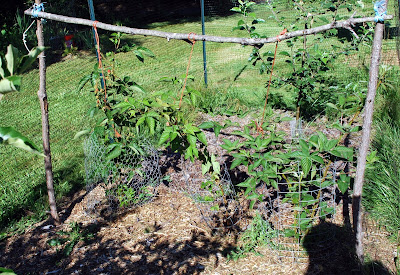 |
| Fenced Apples and Blackberries. 6.29.17 |
 |
| Ebony King Blackberries. Year 2. 6.29.17 |
I think I have enough blackberry cultivars for trial. It will take 2 or 3 years to see how they really produce, and that will also give me a chance to see how they survive the weather. Three of the cultivars were planted last year in the winter and spring, and two are planted this year in spring and early summer. Triple Crown was a container plant from a nursery, that was planted within the past month. Despite hot weather, it's growing nicely.
 |
| Blackberry Columbia Star. One year. 6.29.17 |
The varieties are:
Ebony King - old variety, probably diploid, some thorns.
Prime Ark Freedom - new variety, tetraploid, thornless.
Columbia Star - trailing, thornless. I'm guessing this is tetraploid but I don't know yet.
Arapaho - tetraploid, thornless.
Triple Crown - I think tetraploid, thornless.
 |
| Blackberry Prime Ark Freedom. 6.29.17 |
So far the biggest challenge is deer and rabbit browsing.
Deer browse the tops, eating a significant part of the new growth. That was a major set back last year, resulting in some complete loss of Prime Ark Freedom - half of the plants that I bought - plus they pulled Columbia Star out of the ground and destroyed most of the top, and ate half of the growth of the Ebony King. Deer even ate the somewhat thorny Ebony King. I notice they eat the tops of the brutally thorny local invasive Himalayan blackberries, but only the succulent tops with soft thorns. All are in enclosures or cages now.
Rabbits ate off the emerging canes, up to one foot - thornless Prime Ark Freedom and somewhat thorny Ebony King. That means, enclosures must also protect to the ground, Chicken Wire works for that.
I expect to taste some
Ebony King in a few weeks, from the one plant, of three, that is producing this year. All of the Ebony King are producing primocanes now, more vigorous than last year, and I hope my enclosure prevent loss of growth this time. There may be a taste of a couple of
Columbia Star blackberries, although only a couple from canes that survived the trauma and winter. Prime Ark Freedom is primocane bearing, so there is a chance to sample those in a few months.
 |
| Blackberry "Arapaho" . Two Months. 6.29.17 |
 |
| Blackberry Triple Crown. One Month. 6.29.17 |
Only two of the Prime
Ark Freedom survived the winter with strong growth emerging this spring, one stronger than the other - very vigorous. However, I see tiny plants emerging from the roots of what I think are the plants that appeared to die off completely.
Of the new plants that I started this spring, Arapaho is getting off to a good start, and both plants have nice primocanes emerging. They are in protected cages. I may rearrange the beds this summer or fall, for better access and neatness. The
Triple Crown was blooming in the nursery pot, at only a foot tall. There is a nice primocane emerging from that one as well. I will leave the berries on the plant, to get a taste, if they develop.
If all goes well, there should be a taste of 4 varieties this year, maybe a few bowls of berries in 2018, and a good sized crop in 2019. That is a big "if", but life makes no promises. Gardening is always a bit of a guess, a bit of a gamble, some promises, some science and information, some work and some luck.